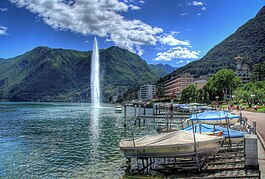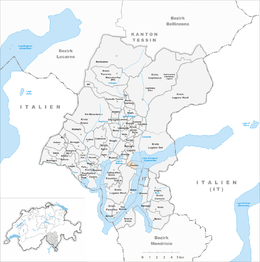Paradiso, Switzerland
| Paradiso | ||
|---|---|---|
 |
||
|
||
| Coordinates: 45°59′N 8°57′E / 45.983°N 8.950°ECoordinates: 45°59′N 8°57′E / 45.983°N 8.950°E | ||
| Country | Switzerland | |
| Canton | Ticino | |
| District | Lugano | |
| Government | ||
| • Mayor | Sindaco | |
| Area | ||
| • Total | 0.89 km2 (0.34 sq mi) | |
| Elevation | 274 m (899 ft) | |
| Population (Dec 2015) | ||
| • Total | 4,054 | |
| • Density | 4,600/km2 (12,000/sq mi) | |
| Postal code | 6900 | |
| SFOS number | 5210 | |
| Surrounded by | Lugano, Lake Lugano | |
| Website |
www SFSO statistics |
|
Paradiso is a municipality in the district of Lugano in the canton of Ticino in Switzerland. It lies on the shore of Lake Lugano and, although administratively independent of the city of Lugano, it is surrounded on all other sides by that city.
Paradiso is first mentioned in 1335 as Calprino. In 1835 it was first called Paradiso from a district of the village, though that didn't become the official name until 1929, also to avoid confusion with the hamlet of Caprino, across the lake.
Excavations in 1951 in Calprino discovered evidence of a Roman era settlement in the area. In the 7th century, there was a small Langobard settlement in the same area. The settlement of Morchino goes back to the 8th Century, while Calprino, Fontana and Guidino are each mentioned between the 12th and 14th centuries. In 1040 the Benedictine monastery S. Carpoforo owned land in Calprino. Between 1264-1375, they owned extensive lands and an episcopal fief in the village. In the 12th century, the Benedictine Abbey S. Ambrogio in Milan owned land in Guidino. By about 1335, the settlements that now make up Paradiso, formed part of the Council of sancti Petri di Pamio. The Council existed until the 19th Century and administered the community properties.
The church of Paradiso was the parish of Pambio. The Chapel of Beata Vergine alla Geretta has been occupied since the 16th Century.
The village economy was based on agriculture, mostly grain and vineyards. Then, in the 18th and 19th Century, the silk industry entered the village. Thanks to the views over Lake Lugano, Paradiso became a popular holiday resort after the opening of the Gotthard Railway in 1882. The funicular railway up Monte San Salvatore opened in 1890. The funicular and increasing lake traffic contributed to the further development of the hotel and tourism industry in Paradiso. At the same time, the population grew. The construction of the highway along the municipal border with Lugano in 1966 began to change the character of the municipality. At the beginning of the 21st Century, tourism began to decline and Paradiso began to develop into a residential community with many luxury buildings.
...
Wikipedia




